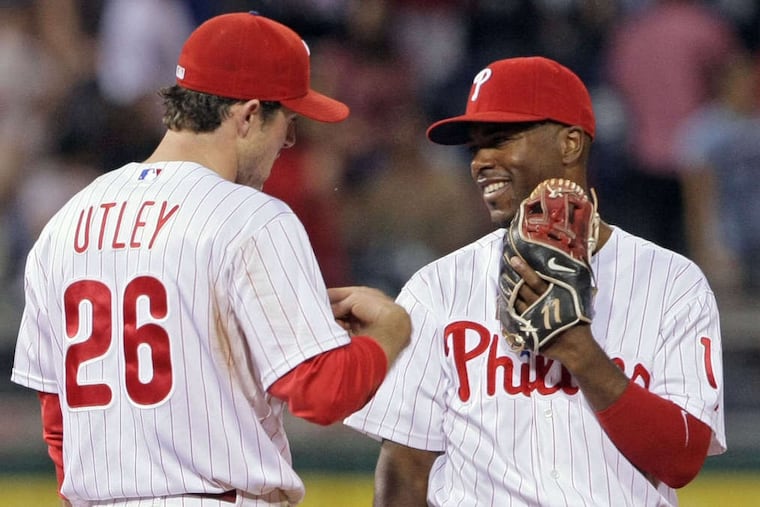Dick Allen and Billy Wagner are headed to the Hall of Fame. Which Phillie will be next?
Chase Utley is well-positioned to someday reach the 75% mark for election, but Jimmy Rollins and Bobby Abreu are spinning their wheels.

Billy Wagner doesn’t do subtlety. He comes right at you, with a blazing fastball and straight talk. So, if anyone wondered which team’s cap he will choose for his Hall of Fame plaque, he wore an Astros polo on a Zoom call with reporters Tuesday night.
Got it? Good.
It makes sense. Because although Wagner often says he had his best seasons with the Phillies, they were two years in a career that spanned 16. The Astros, meanwhile, drafted him out of tiny Division III Ferrum College, brought him to the majors, and made him a closer. He pitched more than half of his 903 innings for them and is tight with Hall of Fame Astros teammates Craig Biggio and Jeff Bagwell.
» READ MORE: Former Phillies closer Billy Wagner elected to Hall of Fame, joining Ichiro Suzuki and CC Sabathia
But while Wagner’s bronze cap almost certainly will feature Houston’s five-pointed star, it’s a decent bet the curly ‘P’ also will be on display this summer in Cooperstown, N.Y.
Dick Allen got elected to the Hall of Fame last month by a 16-person committee, and if the late slugger’s family and the Hall agree that he should go in as a Phillie, he would be the first inductee with that designation since Jim Bunning in 1996. Allen won his MVP award with the White Sox but spent the bulk of his career with the Phillies, who retired his No. 15 in 2020.
A verdict is expected next month. Stay tuned.
But if Allen is next to wear a Phillies cap into the Hall of Fame, who will follow him? This week’s voting results offered a few clues.
Chase Utley is well-positioned to someday reach the 75% mark for election, probably not next year but maybe in 2027 or ’28.
Jimmy Rollins and Bobby Abreu are spinning their wheels.
CC Sabathia’s first-ballot election may prompt some voters to recalibrate long-held Hall of Fame thresholds for starting pitchers, but Cole Hamels still will face a long road when he comes on the ballot next winter.
It’s difficult to separate Utley and Rollins, the best double play tandem in Phillies history. But just like with Alan Trammell and Lou Whitaker, voters have made a clear distinction. In two years on the ballot together, Utley has gotten more than twice as many votes (268) as Rollins (128).
Utley does well with advanced metrics that weren’t en vogue for much of his career. For instance, from 2005 to 2011, he tallied more wins above replacement (49.3) than anyone except Albert Pujols (57.4). But the metrics only back what most Utley supporters already believed, notably that he was the best second baseman in the sport for at least seven seasons before injuries short-circuited his career and left him lacking in various statistical counts (less than 1,900 hits; barely 1,000 RBIs).
Rollins’ best season, when he won the MVP in 2007, was 15% better than any of his others, according to OPS+. His candidacy is based more on durability and longevity — and the numbers that he accumulated over 17 healthy seasons. He’s the all-time leader in hits for a 141-year-old franchise and the only shortstop ever with more than 2,400 hits, 200 homers, 400 steals and 800 extra-base hits.
Yet Utley appeared on 39.8% of ballots after debuting last year at 28.8%, an 11-point bump that represented the third-largest year-over-year increase, while Rollins reached only 18% after totaling 9.4%, 12.9%, and 14.8% in his first three years of eligibility.
Why the discrepancy? It seems more voters are impressed with a higher, if shorter, peak than a longer, flatter career.
Utley is tracking more favorably than Scott Rolen, who didn’t reach the 35% mark until his third ballot and got elected on his sixth. A closer comparison might be Billy Williams, whose first two vote totals (23.4% and 40.9%) resembled Utley’s. Williams climbed to 50.1%, 63.8%, 74.1%, and finally 85.7% in 1987.
It may not take Utley quite as long, if only because there isn’t a no-brainer first-ballot candidate for the next two years. A less crowded ballot will be good news for near misses Carlos Beltrán and Andruw Jones. Utley, too.
Maybe Rollins will benefit from an Utley surge. But Rollins’ vote total ticked up only 1.9% two years ago when Utley joined the ballot and 3.2% this year.
It’s possible to make a jump after stagnating for a few years. Wagner treaded water for four ballots (10.5%, 10.2%, 11.1%, and 16.7%) before pole-vaulting to 31.7% on his fifth. But Rollins and Abreu, entering their fifth and seventh years on the ballot, have to get out of the teens soon.
» READ MORE: Rethinking Andy Pettitte’s Hall of Fame case and what it might mean for Cole Hamels’ chances in 2026
Hamels’ first go-around for Hall consideration comes at an interesting time. Andy Pettitte got a 14.4% bounce from last year, largely because of his statistical similarities to Sabathia. But Pettitte, with only three more years of eligibility, still came in at only 27.9%, hardly putting him on Cooperstown’s doorstep.
Like Pettitte, Hamels did not win a Cy Young Award and often wasn’t the best pitcher on his team. But he was a World Series MVP, and, based on ERA+, he was 23% better than league average over the course of a 15-year career. He also had nearly the same WAR as Sabathia (59.0 to 62.3) and a better ERA (3.43 to 3.74), albeit in nearly 1,000 fewer innings.
Hamels isn’t getting into the Hall of Fame next year. But his credentials should at least give voters something to think about.